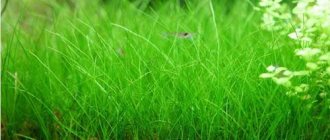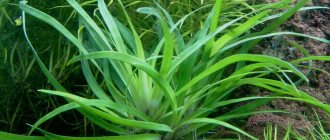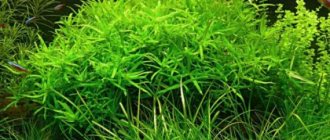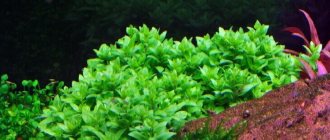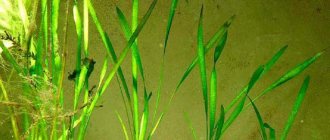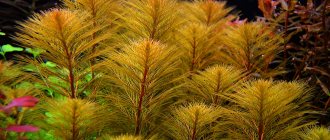Key moss grows in large groups, forming magnificent openwork thickets, gracefully decorating the aquarium. Its ascending and highly branched stems, under optimal conditions, can grow from 50 to 60 cm. On the round or faceted stems of fontinalis, small oval leaves, 1 cm long and 0.6 cm wide, are densely located, pointed towards the apex.
Depending on the growing conditions, the size and shape of the leaf blade may change, as well as the color of the entire plant, changing from brown-red to lush green. The lower part of the stem forms small root-like outgrowths - rhizoids. Through them the nutrients necessary for the plant are supplied.
Also, with the help of rhizoids, the plant attaches itself to solid objects - stones, snags, hard rough substrate, etc. Since the plant is rootless, it does not need a substrate - fontinalis feels great, both floating freely in the water column and being attached to rhizoids any item. In order for the plant to take hold, it is enough to press it against a rough or porous surface and not disturb it for 2-3 months.
Key moss has fallen victim to stereotypes and myths that it is only a “cold-water” plant, does not tolerate temperature increases and must die off in the winter. Unfortunately, this deep misconception most likely occurred due to the fact that the plant has the name “key moss”, which is associated with cold spring water.
Another probable reason for the appearance of these legends may be due to the fact that fontinalis grows in zones with a temperate climate, where all plants shed their green foliage or, like annuals, die off with the onset of winter. Since key moss slows down in winter, changes color and enters a dormant phase, uninformed aquarists may decide that in winter the plant’s gorgeous emerald stems simply die off.
Today, many websites and forums are full of information about certain specially bred “warm-water” types of fontinalis. And instead of going to explore nearby bodies of water or the coastal zone where key moss usually lives, aquarists are enthusiastically busy searching for the mythical “warm-water” fontinalis. And what’s most interesting is that they find it and, unfortunately, pay a lot of money to purchase a plant common to our latitudes, which is found in almost any body of water.
Key moss, Fontinalis growing places
Aquatic mosses are very abundant and are the most popular plants for aquariums. They look very decorative and transform the interior of any aquarium. They are successfully used as plants for decoration, as well as aquatic cover plants. They can be placed on stones, driftwood, and other substrates. The conditions for keeping mosses are different.
Most of them are unpretentious and can withstand different temperatures and water composition. However, there are also species that are quite difficult to keep in an aquarium. These species should not be purchased by beginning aquarists. Mosses are lower plants. They do not have true roots or leaves. But for a more clear definition of the parts of these plants, it is customary to use the words “leaf” and “stem”. Aquatic mosses are inhabitants of wet, flooded areas, where they can grow both in water and on land. One type of aquatic moss is fontinalis.
Start
Reproduction
Key moss reproduces vegetatively by dividing the “mother” bush. In order not to damage the delicate rhizoids of the plant, it is recommended to place several stones near a large fontinalis bush that sits firmly on the substrate and wait for a while until the moss grows, taking up the free space. Thus, young, established shoots of the plant are formed on the stones, and the “mother” moss bush is easily divided into parts.
Liked? Share with your friends!
Social buttons for Joomla
Habitat of Fontinalis (key moss)
Fontinalis or key moss is found everywhere in the wild. It can be found on almost every continent except Australia. Fontinalis is very often found in water bodies of central Europe and Asia. In our country, it can also be found in slow-flowing rivers and lakes with clean water. Key moss itself is not an aquatic plant, but it adapts well to changing growing conditions. So, growing on land, it can easily adapt to an underwater lifestyle. And, growing in water, it can also transition to terrestrial existence. In the wild, this plant survives well in any conditions.
In an aquarium, fontinalis is quite capricious and demanding, so only experienced aquarists successfully keep and propagate it. For experienced masters, key moss feels great in an aquarium, pleasing the eye with dense, bright green thickets. Taken from a local pond, it often takes root well in the aquarium and grows well. This plant is valuable not only for its original appearance and decorative capabilities. Moss is often used as a spawning substrate for many aquarium fish. It is also indispensable in nursery aquariums, where fry hide in its thickets.
Start
Spreading
A widespread species of the Northern Hemisphere, also found in South Africa, but within this vast range it is rare everywhere [1]. In Russia it is known in the forest zone and forest-steppe, where it has disappeared from many localities [2]. In the Tula region, it was noted at the end of the 19th and mid-20th centuries in the Lupishkinsky swamps in the Kimovsky district [3, 4], the location was confirmed by collections by E.M. Volkova in 2008; was also found in the vicinity. tourist center "Velegozh" in the Zaoksky district and in the spring "12 brothers" near the village. Sviridovsky Venevsky district [5], as well as along the bank of the river. Vashany near the village. Kaznacheevo in Aleksinsky district [6].
Appearance of Fontinalis (key moss)
Key moss is a wonderful aquarium decoration. This plant appears as a bright green bush that sometimes reaches quite large sizes or forms dense thickets. Fontinalis produces many long and branched stems that, with good care, can grow up to 50 cm.
Fontinalis stems are ascending, round or faceted. They are covered with small oval-shaped leaf blades that are pointed towards the top. The leaf blade of fontinalis usually has a length of 1 cm and a width of about 0.6 cm. However, the size of the leaf blades and their shape can vary greatly under different maintenance conditions. The color of the entire plant may also change. Fontinalis moss can range in color from bright green to reddish-brown. On the lower part of the moss bush, whitish outgrowths are formed - rhizoids. These outgrowths are similar to the roots of a plant, but rhizoids are not roots. The plant feeds through them, but mosses also feed through the entire outer surface of the plant.
The main function of rhizoids is to secure the plant to a specific surface. The moss bush may attach itself to a rock or driftwood. It will stick best to a rough surface. However, moss does not need to attach itself to the substrate. He will feel great just swimming in the water. If, for decorative purposes, it is necessary to attach moss to any object, you need to understand that this will not happen soon. The moss bush must be pressed or carefully tied to an object and not moved for 3 months.
Moss fontinalis is a common aquatic plant in our latitudes. If desired, it can be found in almost any of our bodies of water and placed in an aquarium. Under good conditions, this plant will grow and look beautiful in the aquarium all year round. A common misconception is that fontinalis grows only in summer and dies off in winter. Yes, this species is a cold-water plant, but it is perennial and lives quite a long time. Most likely, this misconception is due to the fact that many plants in our latitudes either die off during the winter, or shed their leaves and go into a dormant state. In this regard, information is persistently disseminated that a new warm-water species of fontinalis has been developed, which can grow in an aquarium all year round. In fact, in the wild, with the onset of winter, fontinalis changes color and slows down its growth, going into a dormant state. And when growing moss in an aquarium, it will also need rest. After spending the winter period of time at rest, the fontinalis will turn green again and begin to grow intensively in the spring. And the artificially bred warm-water species of moss is the same spring moss common to our latitudes, which can be found in the nearest body of water. You should not pay a lot of money for a mythical plant; it is better to explore a nearby lake and purchase this very valuable and beautiful plant for free.
Start
Java moss and its growth characteristics
Java moss has a slow growth rate. At first, when the plant has not yet “rooted”, that is, has not attached itself to the substrate with the help of rhizoids, its growth can be almost imperceptible. Such low growth rates can continue for up to several weeks. And only after the plant has produced a sufficient number of rhizoids will its growth rate increase. Then you can see the appearance of a significant number of light green young shoots.
The growth of Java moss seems chaotic, however, in reality it is not so. Observations show that moss growth initially occurs to the sides and downwards, thereby ensuring a reliable connection of the plant with the substrate on which it is fixed. After being securely attached to the substrate, the moss bush produces shoots directed horizontally and slightly upward. This happens until the moss bush gains the required mass. And only after this, Java moss produces many shoots directed vertically upward.
Conditions for keeping Fontinalis (key moss)
Key moss is characterized by seasonal growth. This midland plant requires dormancy in winter. If the moss is not given a period of rest, the plant weakens. As a rule, it survives the winter, but by the next winter it dies. This is the reason for the failures of inexperienced aquarists when growing fontinalis in aquariums.
In summer, the optimal temperature for growing fontinalis is from 15 to 26 degrees. This plant can withstand much higher temperatures. Temperatures of 30 – 32 degrees in combination with bright lighting are tolerated by the plant only when fertilized with microfertilizers. Without this, the plant may die. In winter, the water temperature should be significantly reduced. To maintain the plant during the dormant period, a temperature of 10–12 degrees is sufficient. It is not necessary to bring the temperature in winter to the usual winter temperature of an open reservoir (about 0 degrees and below). It is not possible to organize a rest period for fontinalis in a general aquarium, since few of its inhabitants are able to withstand such a low temperature. Therefore, for the winter, the plant is transferred to another container, which will be located in a room with a lower temperature. Thus, conditions close to natural are created for this plant.
Fontinalis is not particularly picky about the composition of water, however, observations have shown that the plant feels better in soft water that has a slightly acidic or neutral reaction. Of particular importance for growing spring moss is the purity of water and its high-quality filtration. Turbid water and debris are detrimental to this plant. In muddy water, moss bushes become covered with a dirty coating, which makes it difficult for the plant to feed. In such conditions, the moss withers and quickly dies. When keeping spring moss, it is recommended to change a fifth of the water once a week.
Also, when keeping key moss, you must carefully select the fish that will live in this aquarium. Fish eating plants or digging in the soil will destroy the delicate moss. Only small viviparous or characin fish can live in the same aquarium with fontinalis.
Lighting for fontinalis is best done diffused and not too bright. In bright light, lower algae can settle on moss branches, which will cover the moss and lead to its death. Daylight hours in an aquarium containing key moss should be about 11 hours.
Table of basic maintenance and care parameters:
| What should the temperature be? | from +18-30 °C (depending on the type) |
| What should the pH be? | from 5-8 |
| What should be the stiffness? | 4-20°dkH |
| What should the substrate be? | lands on snags, stones and other decorations |
| What kind of lighting should there be? | from 0.5 to 0.7 W/l for 12 hours this is a light-loving plant |
| Maximum height | up to 25 cm (depending on the type) |
| Maximum width | up to 10 cm |
| Growth rate | weak |
| Content complexity | simple or medium (depending on the type) |
The most popular aquarium plants for beginners
The fashion for certain types of plants changes, but there are also those that do not lose popularity. They are easy to care for and are decorative.
Foreground
Anubias, cladophora, marsilia and various mosses are often used for it. Just a few of these plants can create an interesting landscape.
Some unpretentious aquarium plants for foreground decoration.
Center
The choice of plants for this part of the aquarium is greater: ferns, bacopa, sinema, alternatera, staurogyne, as well as the whole variety of echinodorus and cryptocorynes.
The background
The back wall of an artificial pond is most often decorated with valisneria, cabomba, hornwort, nayas, elodea, crinum and lemongrass. Thanks to the variety of shapes and colors of the foliage of these algae, an aquarium of 3-4 species can create a beautiful appearance.
- Choosing the best background plants! — New look for an old aquarium
- Choosing the best mid-ground plant! — A new look for an old aquarium
- Choosing the best foreground plant! — New look for an old aquarium
To bookmarks
Popular varieties
Experts use different types of spore-bearing plants to create a beautiful landscape
Mosses differ from each other in size, leaves, properties and habitat, so when choosing a specific species it is important to know the characteristics of each. Let's look at their description and which aquarium mosses are used most often
Riccia floating
Riccia is most often bred in aquariums; if we consider all species, then these mosses are the most unpretentious in care. It has no leaves or stem. Riccia will live as an underwater plant, as a soil crop in a terrarium, as a place for spawning fish, and as a refuge for fry. It improves the microenvironment, affecting the circulation of substances. Growing in a reservoir, it forms a carpet more than a centimeter thick. If the green color of the plant changes to red, it means that the conditions have become unfavorable.
Riccia floating
Best conditions of detention:
- ambient temperature from 22 to 28 °C;
- water should be Ph neutral and soft;
- requires bright illumination with fluorescent lamps;
- the green mass must be partially removed to prevent large growth;
- To prevent unwanted growth from occurring, it is recommended to place Riccia in a floating circuit.
Phoenix moss
The phoenix is widely found in the natural environment and has a beautiful appearance: small in size and fluffy, which is why this green ball is often put in the foreground when decorating. It is planted on a substrate to which it quickly attaches, but grows slowly. The shoot can easily be attached to any place, on a net or snag. For active growth of the phoenix, additional light is required. The remaining conditions of detention are simple, he does not need feeding, he obtains all the necessary substances on his own.
When decorating a space with it, it should be taken into account that the plant grows upward, and the thickets can be laid out on the bottom to be used for spawning purposes.
Phoenix moss
Best conditions of detention:
- favorable temperature from 23 to 28 °C;
- does not require water of a certain hardness;
- it is necessary to maintain the purity of the aqua, periodically replacing from 30 to 50%;
- To provoke active growth, additional lighting and feeding are necessary.
Java moss
The Javan species is very beautiful in appearance, so aquarium decorators often use it. It has long shoots and side shoots, narrow flattened leaves. Like the phoenix, it grows vertically, so it is recommended to use it for the background or wall.
Java moss
Conditions of detention:
- no special lighting required;
- does not require special temperature conditions;
- neutral acidity of the environment is recommended;
- does not require fertilizing;
- It does not attach well to the substrate, so to avoid floating, it must be tied down.
Riccardia
Riccardia belongs to the hepatic class and can live in any environment. The plant is creeping, to form a beautiful bush it needs to be cut. Pruning is also necessary to prevent rotting of the lower layers, which can lead to the death of the entire plant.
Riccardia
Favorable conditions of detention:
- temperature from 21 to 24 °C;
- the light should be bright, additional lighting is recommended;
- water is suitable for any characteristics;
- the aquarium must have a filter, otherwise riccardia, like a sponge, will absorb all harmful substances;
- grows to any substrate, however, initially it needs to be attached with threads, then the plant itself will attach to the surface;
- It is recommended to organize an additional supply of carbon dioxide into the water.
Monoselenium
Monoselenium belongs to the hepatic species, has a flat leaf-like shape, and exists in a colony. The plant is tender, so it is easy to damage. Under the conditions of detention it is absolutely not whimsical. Temperature, lighting and water characteristics are not important. To prevent the plant from floating, it requires attachment to the substrate. It can be grown above water, so it is used for a wet terrarium, but in this case the spore plant will change color. The advantage of monoselenium is that fish do not feed on it. The best place to decorate an aquarium is in the foreground.
Monoselenium
Opinion of mosharnik owners
Owners of aquatic aquarium moss speak well of the “Rozhdestvensky” variety. This variety is so called because the leaves that form on the stems look very similar to Christmas tree needles up close. Christmas moss , like the Singapore variety, is often used to decorate small artificial ponds. The owners claim that the moss is not capricious, but stops growing as soon as the water temperature drops below 20 ° C.
Christmas moss has a rich dark green color, and the leaves on the branch line up like a holiday spruce.
Owners of other varieties give mostly positive reviews and claim the following:
- moss on coconut or driftwood grows well even in the shade and at low temperatures (for example, the famous Queen, or royal variety);
- moss grass absorbs nutrients from the environment over the entire surface, and not just the part that is underground;
- the presence of this easy-to-maintain culture in the aquarium has a positive effect on the health and longevity of the fish;
- moss grass renews itself and reproduces on its own and does not require human intervention (the anchor variety reproduces the fastest);
- due to the absence of roots, the crop can be easily transferred to a new place, and it will easily adapt to new conditions.
Moss is also inexpensive and available for sale wherever aquarium accessories are sold. Most often these are the “marimo” and “spike” varieties; they adapt best to artificial reservoirs. The peacock variety (peacock), distinguished by its richness of colors and similar to mossy algae, is more expensive than the others. The background in the aquarium made of peacock moss goes well with colorful small fish.
When purchasing one or another type of moss, the owner must provide the plant with proper care and a suitable humidity regime. In the absence of proper care, moss grass can rot; then the fish will die, poisoned by decay products. Therefore, when growing at home, you should monitor the condition of the green coating daily.
How to propagate plantings and create decorations from key moss
Key moss reproduces vegetatively. New plantings can be obtained by dividing the mother bush
In this case, you should be careful to avoid damaging the plant.
It is better not to cut the bushes, but to wait until young shoots grow from them and become sufficiently established in the ground or on the surface of any decorative element, forming new, strong plantings. After this, they can be easily separated and secured in the chosen location.
As mentioned above, key moss feels great both in the ground and on other vertical or horizontal surfaces. This allows aquarists to give free rein to their imagination and decorate the underwater world with such greenery in accordance with their own taste.
Aquarium design process
It is very labor-intensive, especially if you use decorative or delicate species. All plants that cling well to the surface can be tied with threads. Mosses that do not attach well to the bottom or internal decorations (snags, stones) are best tied with fishing line, as the threads will rot in water.
All mosses can be attached using superglue. This is especially helpful when you need to attach moss in a non-standard place or create an original composition, although here you need to know special subtleties so as not to poison the fish. When decorating, you need to periodically spray the moss with water.
https://youtube.com/watch?v=v1VmPeHgz5I
Decorative properties of Java moss
Photo background inlaid with Java moss:
From the editor: Christmas tree pinnate
Taxiphyllum barbieri is one of the most common and favorite aquatic plants among aquarists. Java moss is successfully used in aquarium decoration. Taxiphyllum Barberi is distinguished by its ability to attach well to porous decorative elements. Looks great on rocks, driftwood, coconut and even pipes, forming loose green balls on them. Green underwater meadows covered with moss look very decorative.
“Java Moss” is widely used as a background when decorating the back wall of an aquarium, as well as to disguise filters, heaters and other aquarium equipment. In order for the moss to maintain its appearance and not grow excessively, it is necessary to monitor its growth and periodically trim its shoots.
Examples of the use of such decor are clearly visible in the photographs above. It is best to secure Java moss to the decor with cotton thread; over time it will rot, and during this time the moss will fix itself with the help of rhizoids. The sprigs of moss should be pressed tightly against the decor, because it will only attach where the rhizoids touch the stone or driftwood.
Timofeeva Yulia Alekseevna
Main
Description
As mentioned above, moss also belongs to higher vascular plants, but they are separated into a separate group. It is generally accepted that the first mosses appeared about 400 million years ago. Currently, scientists distinguish 3 classes of moss. So, they include:
- Antocerotes.
- Bryophytes.
- Hepatic.
As a rule, aquaists in most cases use only real mosses, which are characterized by a variety of aquatic species. Liver mosses, the representative of which is Riccia floating, are less popular.
